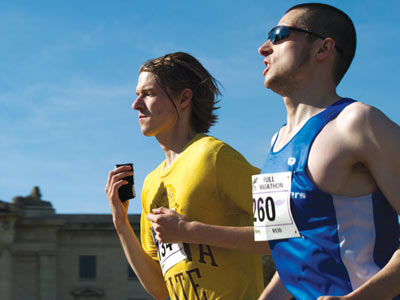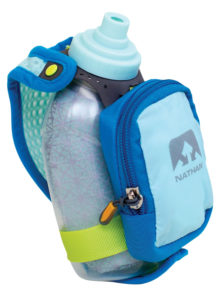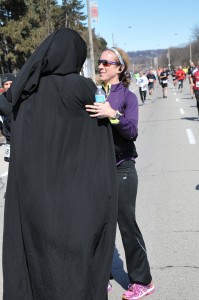
By Ed McNeely
For many athletes, a year of training comes down to one major race when strength, skill, speed, endurance and tactics all need to come together at the right time. The final preparation for competition is both an art and a science, requiring an understanding of the physiological changes that are occurring, and the skills to manage the psychological and emotional state of an athlete as they near the culmination of a hard year of training.
While the scientific community has done a good job of determining the adaptations that occur with tapering, to date there has not been a definitive study or series of studies on the optimal combinations of intensity, volume, frequency, duration or format of a taper.
This does not mean that tapering is not a critical step in the process of reaching a higher level of performance for recreational and world class athletes. But it does mean that the recommendations used to form the basis of a taper should be modified to suit the physical, technical, tactical and psychological needs of each athlete.
The objective of training is to induce physiological, psychological, technical and mechanical changes in an athlete so that performance improves. The objective of a taper is to remove or decrease the athlete’s training stress to facilitate a delayed training effect where the body continues to adapt as fatigue dissipates, allowing the full fitness effect of the training period to be realized.
Adaptations to a taper
Various physiological adaptations, that are allowed to fully express themselves once the fatigue from constant training is removed, are responsible for the 3-11 per cent improvement in performance reported during a taper in endurance athletes. Some of the physiological adaptations that occur for endurance athletes include:
- VO2 max increases or remains unchanged during a taper
- Hemoglobin and hematocrit values have been shown to increase, thus increasing the oxygen-carrying capacity of the blood
- Peak blood lactate values are increased during a taper, thus acting as a buffering system serving to limit lactic acidosis to delay fatigue
- Sport specific muscle power increases during a taper are often greater than the improvement in aerobic fitness and may account for most of the taper induced performance improvement in endurance athletes.
Designing a taper
It has been our experience that the competitive level of the athlete and their training volume will dictate the need for and benefits seen during a taper; not every athlete will benefit from a taper. Tapers then should be categorized according to their post-taper requirements.
Zero Taper
Endurance athletes who are training less than four hours per week will not benefit much from a true taper because their training volume is low enough that fatigue is unlikely to accumulate from week to week. These athletes can take a day or two off immediately before a race and be sufficiently recovered to race at their best.
Minor Taper
The minor taper is used prior to performance tests (lactate, VO2 max and performance testing) that are used for selection or monitoring training and/or less important races. The design of the minor taper depends on normal training volume. Athletes who are training 6-10 hours per week will take one day completely off before the test or race; those training 10-15 hours per week will use a three day taper of reduced volume; and those training more than 15 hours per week will use a five day taper of reduced volume.
Moderate Taper
The moderate taper is used for secondary races, those races where a good performance is needed in order to qualify for an upcoming event, or to test where you are at with your training in a racing scenario. These races should be races where an athlete is confident of their ability to perform well even if they are not fully rested. Athletes who are training 6-10 hours per week will use 3-5 days for a moderate taper; those training 10-15 hours per week will use a 7-10 day taper; and those training more than 15 hours per week will use a 10-14 day taper. The design of the moderate taper will follow the intensity, volume and frequency recommendations below for the major taper.
Important: Keep careful and detailed records of the training sessions used in the moderate taper. Recording both objective and subjective data like feelings of recovery, muscle soreness and athlete confidence provides information to help design the year’s major taper.
Major Taper
The major taper is used prior to the year’s most important competition. Due to the length of time required for a major taper, it should only be used once per year.
Duration
Since the training stimulus is greatly reduced during a taper, the duration of the taper can have an impact on the magnitude of performance improvements. Within 1-4 weeks of stopping training, highly trained athletes start to show decreases in some aspects of performance possibly due to a “loss of feel” during training and competition. The number of days needed for a taper to be effective may be affected by training volume and intensity leading up to the taper and the fitness level of the athlete.
Volume
For those who are training more than four hours per week, the major taper needs to be planned according to work volume. During a major taper of 14 days or longer, training volume should decrease by 60%-90%. In other words, if an athlete is normally training 10 hours per week and will be doing a 7 day taper, they will only train 3 hours during the taper week.
Two types of volume tapers:
- Progressive volume taper: Where training volume is decreased gradually over the duration of the taper.
- Step taper: Where volume is reduced rapidly, often in a single step.
The advantage of the progressive taper over the step taper is probably due to detraining effects that occur when the rapid volume decrease used in step tapering is maintained for an extended period of time. While a progressive taper is the obvious choice for the major competition of the year, a step taper may be better for minor and moderate tapers where the taper duration is less than 10 days.
Frequency
The reduction of training volume in a taper should not occur as the result of drastic changes in training frequency rather, the decrease in volume is accomplished by decreasing the duration of each workout. In the more technical endurance sports like swimming, rowing, skiing and kayaking, maintaining a training frequency of 5-6 days per week may help prevent decreases in technical efficiency. In less technical endurance sports like running and cycling, frequency can be decreased by up to 50% particularly in the final week prior to a competition.
Intensity
As a taper progresses, training intensity increases and training volume decreases. Steady state workouts are gradually replaced with higher intensity intervals and short sprints. By the final week race pace or near race pace work will be done almost daily.
Important: It has been suggested that decreases in volume and frequency of training may cause some athletes to lose the ‘feel’ of their sport. The retention of skill is related to the extent to which the skill has been learned. Novice athletes who have not automated the skills of their sport are likely to be more susceptible to a loss of skill performance. Novice athletes may benefit more from a continued higher volume of training, to maintain technical proficiency leading into a race followed by 1-2 days off just prior to the race.
The race pace work in the last two days is as much a psychological factor as it is a physiological factor. Race pace intervals and sprints will give the athlete feelings of speed, power and confidence that they can take with them into race day. Many athletes have told us that they feel it is important to have a good final training session that leaves them feeling energized not fatigued. It has been our experience that these final training days are most effective when done on the race course so that the athlete has time to familiarize themselves with the course and surroundings.
A taper is a period of reduced training volume and increased training intensity that occurs prior to a competition. The duration of the taper depends on whether it is a zero taper, a minor, moderate or major taper and the volume of training prior to the taper. A moderate taper should be practiced at least once before the major competition taper of the year. This will provide the opportunity to adjust the taper to individual needs and experiment with different combinations of intervals and sprints during the final week.
Each athlete handles decreased training volume differently. Many athletes will enjoy the feelings of speed, power and renewed energy. However, others have a tough time dealing with the decrease in volume and worry about detraining or don’t know how to cope with the extra free time, as a result of the decreased volume. A coach needs to be aware of the individual responses of each athlete and be prepared to adjust training routines to address their needs.
Ed McNeely is a Senior Exercise Physiologist M.Sc.Kinanthropology CK (Certified Kinesiologist), Ontario Kinesiology Association.
PEAK Centre staff have the highest certifications available in Canada for Sport Science. With their combined experience (including numerous Olympic medallists and teams) and education, PEAK Centre is at the forefront of practical Sport Science application.















 Our Magazine
Our Magazine
